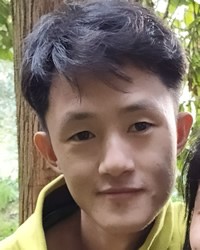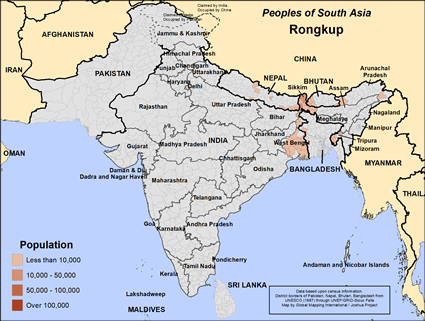Rongkup-Lepcha in Nepal

Photo Source:
Anonymous
|

Map Source:
People Group data: Omid. Map geography: UNESCO / GMI. Map Design: Joshua Project.
|
| People Name: | Rongkup-Lepcha |
| Country: | Nepal |
| 10/40 Window: | Yes |
| Population: | 4,200 |
| World Population: | 86,300 |
| Primary Language: | Lepcha |
| Primary Religion: | Buddhism |
| Christian Adherents: | 3.56 % |
| Evangelicals: | 0.00 % |
| Scripture: | New Testament |
| Ministry Resources: | No |
| Jesus Film: | Yes |
| Audio Recordings: | Yes |
| People Cluster: | South Asia Tribal - other |
| Affinity Bloc: | South Asian Peoples |
| Progress Level: |
|
Introduction / History
The Rongkup are an indigenous people of northeastern India, Bhutan and Nepal. Most of the population lives in India with smaller populations in Bhutan and Nepal. The Rongkup are also called Lepcha. They speak a Sino-Tibetan language called Lepcha. Many Lepcha also speak Nepali, which serves as a trade language among the peoples of Nepal. The Lepcha has its own script based on Sanskrit.
The Rongkup live in the valleys and hills of Nepal south of the Himalaya Mountains.
What Are Their Lives Like?
Most Rongkup engage in farming rice, millet, barley, maize, and wheat along with fruit and vegetables. Fish and chicken supplement their diets. They make an alcoholic drink from millet.
Besides farming, the Lepcha also specialize in carpentry, spinning and weaving. There is no division of labor based on sex. A man may spin and a woman may weave, or vice versa. Men and women work side by side in the fields. Rural citizens of Nepal pay little or no taxes. However, they are required to work without pay for local projects.
Village communities and extended families are a part of the culture. The Rongkup live in scattered communities. Sometimes they build settlements of two or three houses huddled together in heavily forested areas near their fields. They make their houses of finely woven bamboo strips or wood and have thatched roofs.
The Rongkup are gentle and live peacefully with little crime in their villages. They believe that aggression destroys the community, and elders handle all quarrels.
They have an oral culture. Dances, music on traditional instruments and singing take place on holidays.
The Rongkup marry within their group. Families arrange marriages with the consent of the young people. The local shaman finds an auspicious day for the wedding, based on the birthdays of the groom and bride. Due to lack of access to modern medicine, child mortality is high. Couples have many children, so some will survive to adulthood.
What Are Their Beliefs?
Most of the Lepcha consider themselves Buddhists. However, they practice two major religious philosophies: Lamaism, derived from Buddhism, and Mun, a folk religion. Though they are contradictory, they practice these beliefs simultaneously. The Mun religion involves a special relationship with a family spirit. They use animal sacrifices and direct communication to appease and ward off evil spirits that may cause disease or disaster.
For Lamaistic Buddhists, offering animal sacrifices is a terrible sin. They founded their philosophy on reincarnation (continuous cycle of death and rebirth), and they believe that their works in this life will either reward or punish them in their next life.
What Are Their Needs?
Many Rongkup do not have access to electricity or modern medicine. Medical teams of believers can help the Rongkup. The Rongkup people would benefit from the installation of solar panels. Christians can start schools so they can read the Rongkup Bible.
Most of all, the Rongkup need to hear a clear presentation of the good news of Jesus Christ. He alone can forgive their sins and grant them eternal life. He can free them from their fear of evil spirits.
Prayer Points
Ask the Lord to send Christian medical personnel and teachers to share the love of Jesus with the Lepcha of Nepal. Pray that Christian radio broadcasts and evangelical literature will become widely available to the Lepcha. Ask the Lord to save key leaders among the Lepcha who will boldly proclaim the gospel. Pray for a strong church planting movement among Rongkup families.